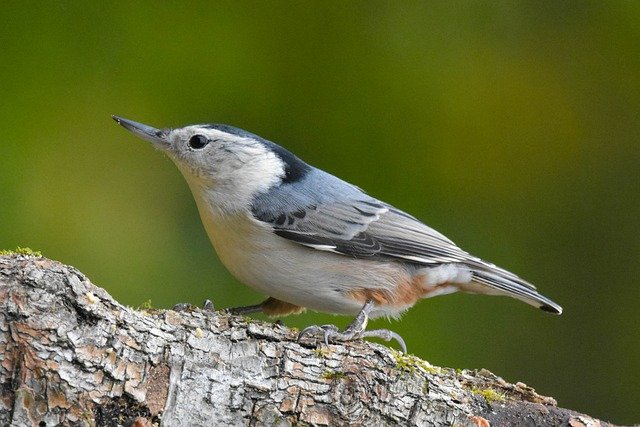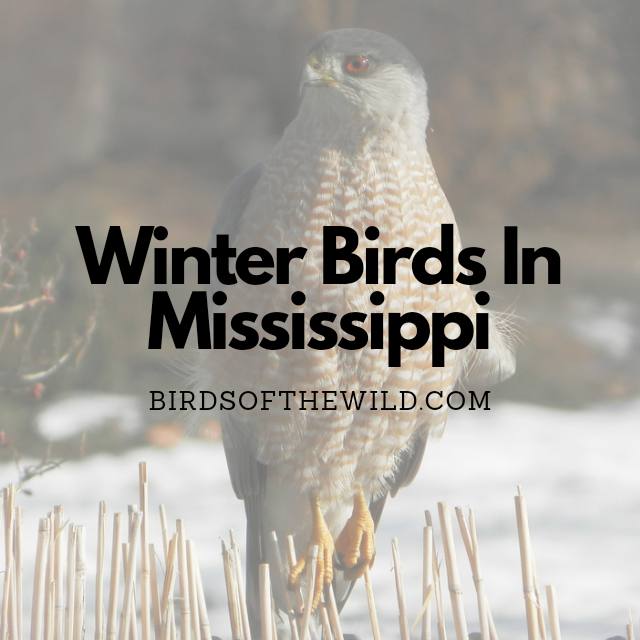In this article I’ll be going over 11 winter birds that can be found in the state of Mississippi so continue reading to learn more about these birds below.
- Bald Eagle
- Peregine Falcon
- Red Tailed Hawk
- Eastern Screech
- Cooper’s Hawk
- White Breasted Nuthatch
- Great Horned Owl
- American Kestrel
- Northern Flicker
- Sharp Shinned Hawk
- Northern Cardinal
11 Winter Birds In Mississippi
1. Bald Eagle (Haliaeetus Leucocephalus)

- Size: 90 – 108cm
- Weight: 3 – 6.3kg
- Wingspan: 180 – 250cm
Bald eagles are winter residents in the majority of Mississippi.
A bald eagle’s plumage consists of dark brown around its wing and body, with white feathers on its tail and head along with the trademark yellow beak and feet. Both male and female bald eagles look relatively the same.
As for where you can find these eagles, it will often be around lakes and reservoirs with lots of fish and surrounding forests. You’ll often find them around unfrozen lakes and hunting along coastlines, reservoirs, and rivers during the winter months
These eagles are birds of prey meaning they hunt other birds, medium sized mammals like rabbits, hares, other animals like reptiles, fish and even eat carrion when their options are limited. Sometimes bald eagles are recognised as fish eagles as their diet consists of fish and as meat is the only thing they eat these eagles would ultimately be regarded as carnivores too.
Bald eagles can live for around 20 years in the wild.
2. Peregrine Falcon (Falco Peregrinus)

- Size: 38 – 48cm
- Weight: 600 – 1300 grams
- Wingspan: 95 – 110cm
You’ll be able to find peregrine falcons in southern Mississippi in the winter months.
Peregrine falcons are recognised by their black head, back and wings, yellow and black beak, yellow feet and a patterned back and white plumage on the belly. Females are once again the bigger of the two with males roughly 33% smaller.
Peregrines live in a variety of unique terrains such as deserts, seashore, mangroves, wetlands, tundra, grasslands, dry forests, scrubland, and craggy mountains.
As for what peregrine falcons eat, it is mostly other smaller birds like pigeons, ducks, shorebirds, other smaller mammals and in the rare occasion carrion.
Peregrine falcons are known to live around 5 – 6 years in the wild and upto 16 years in captivity.
3. Red Tailed Hawk (Buteo Jamaicensis)

- Size: 45 – 60cm
- Weight: 1.25 – 1.47kg
- Wingspan: 100 – 150cm
Red tailed hawks are year round residents all throughout Mississippi including the winter months.
These hawks are recognised by their brown torso and wings, white breast and red tails. The main difference between the male and females is that the females are a third larger than the males.
These red tailed avians spend their time at a variety of places within the state including deserts, grasslands, forests, agricultural fields and urban areas.
Red tailed hawks are carnivorous birds of prey where they feed on small mammals, rodents, other smaller birds, fish and even carrion.
In the wild red tailed hawks are known to live between 15 – 20 years whilst captive red tails can live on the upper end of that spectrum around 20 years.
4. Eastern Screech Owl (Megascops Asio)

- Size: 16 – 25cm
- Weight: 121 – 244 grams
- Wingspan: 49 – 61cm
You’ll be able to spot eastern screech owls all across Mississippi on a year round basis which would include the winter.
Eastern screech owls are recognised by their mostly gray plumage. Females are generally larger and have a feathers that are brown in color.
These owls can be found around open mixed woodlands, deciduous forests, parklands, wooded suburban areas, riparian woods along streams and wetlands.
Eastern screech owls eat a variety of foods from small animals, including birds and mammals as well as earthworms, insects, crayfish, tadpoles, frogs, and lizards.
As for how long these owls are known to live for, it’s typically around the 14 year mark in the wild.
5. Cooper’s Hawk (Accipiter Cooperii)

- Size: 35 – 51cm
- Weight: 400 – 700 grams
- Wingspan: 73 – 94cm
These hawks can be found in the majority of Mississippi on a year round basis and the southern region of the state in the fall and winter months.
Cooper’s hawks are recognised by their gray back and upper head with a orange and white patterned breast, legs and underside of the wing. The females and males look very much the same but, the females are around 30% larger than the opposite gender.
You’ll often find a cooper’s hawk around pines, oaks, Douglas-firs, beeches, spruces, and other tree species, often on flat ground rather than hillsides, and in dense woods.
As for what they eat, it includes mainly medium-sized birds including robins, jays, flickers, among other smaller and even larger birds. Small mammals like chipmunks, tree squirrels, ground squirrels, mice, bats, etc. are included in their diet too.
Cooper’s hawks tend to live for around 10 – 12 years on average whilst the oldest recorded hawk surpassed the 20 year mark.
6. White Breasted Nuthatch (Sitta Carolinensis)

- Size: 13 – 14cm
- Weight: 18 – 30 grams
- Wingspan: 20 – 27cm
White breasted nuthatches can be found in the the majority of Mississippi on a year round basis, including the winter months.
These white breasted nuthatches are recognised by their gray back, wings and the upper head with white breast feathers. Females look the same as the males.
As for where you would find these white breasted nuthatches, it would be around mature woods and woodland edges, where they’re most commonly located by deciduous stands that have maple, hickory, basswood, oak and are even found in some coniferous forests.
They mostly consume nuts, seeds and insects, which can include hazelnuts, sunflower seeds and suet.
As for how long white breasted nuthatches live in the wild, it tends to be around 2 years with the longest lifespan recorded around 12 years.
7. Great Horned Owl (Bubo Vrginianus)

- Size: 57 – 63cm
- Weight: 1.4 – 1.5kg
- Wingspan: 1.35 – 1.5m
Great horned owls can be found all across Mississippi year round including the winter months.
These large horned owls are recognised by their brown/gray plumage with their defining feature being the tuft of feather on the top of their head resembling a horn or ear like feature. Male and female great horned owls look relatively the same with the females slightly larger in size.
At night these birds will perch on a branch or a tall building to look around for prey and once the desired prey has been found they will fly towards it with folded wings, grab the prey with their talons piercing through their body and in most cases killing them immediately.
As for what these birds eat it includes smaller prey like rodents, frogs or scorpions. Even other larger predators like geese, ducks, hawks, and smaller owls can be eaten by these carnivorous birds.
Great horned owls are most commonly found in deserts, wetlands, forests, grasslands, backyards, cities and they can also be found in semi-open habitats between the Arctic and the tropics.
As for a great horned owls lifespan, it can be anywhere from 15 -25 years.
8. American Kestrel (Falco Sparverius)

- Size: 20 – 24cm
- Weight: 115 – 125 grams
- Wingspan: 50 – 60cm
You’ll be able to spot American kestrels across the majority of Mississippi year round and in the western region of the state only in the winter.
American kestrels are recognised by their spotted orange, gray, black and white plumage with their back orange with a black horizontal pattern, their wings a gray color, black tail feathers and orange sides with a gray and white head that has 2 black lines drawn vertically near both eyes. Females are mostly light brown.
American kestrels can be found in a variety of open or semi-open habitats from forest clearings, farmland and deserts.
As for what they eat, it includes small mammals such as woodmice and shrews, small birds, insects, earthworms with voles being their go to food source.
Wild American kestrels are known to live for around 5 years but, captive variants have been known to hit 17+ years.
9. Northern Flicker (Colaptes Auratus)

- Size: 30 – 35cm
- Weight: 115 – 125 grams
- Wingspan: 50 – 55cm
These northern flickers can be found all across Mississippi year round, which inlcudes the winter months.
Northern flickers are recognised by their mostly cream colored body with black spots, orange and black tail feathers and elements of red on the lower part of their face. Females look very similar to the males minus the red elements on their face.
You’ll often find northern flickers around woodlands, forest edges, and open fields with scattered trees, as well as city parks and suburbs.
As for what they tend to eat, it includes mostly insects along with smaller fruits and berries.
Northern flickers are known to live for around 5 – 7 years on average with the longest recorded to be 9 years and 2 months.
10. Sharp Shinned Hawk (Accipiter Stratus)

- Size: 23 – 37cm
- Weight: 82 – 220 grams
- Wingspan: 42 – 68cm
Sharp shinned hawks are year round residents across northern Mississippi and winter residents in the remainder of the state.
These hawks are recognised by their gray wings and back, brown and white breast and belly with a pair of yellow feet. Females look very similar to the males but are roughly a third larger.
Sharp shinned hawks can be found around mixed or coniferous forests, open deciduous woodlands, thickets, edges
These hawks will often eat birds from the size of a sparrow up to that of a robin’s size and in rare occasions some birds that are the size of quails too. They also eat the occasional rodent, bats, squirrels, lizards, frogs, snakes, and large insects.
Sharp shinned hawks will typically live for around 5 – 6 years on average, although some are able to live 10+ years in the right environment.
11. Northern Cardinal (Cardinalis Cardinalis)

- Size: 21 – 23cm
- Weight: 42 – 48 grams
- Wingspan: 30 – 35cm
You’ll find northern cardinals in Mississippi on a year round basis, which includes the winter months.
Northern cardinals are recognised by their mohawk-like head feathers, red exterior and beak with elements of black across the face. Females also have elements of red on their beaks and their body but, in smaller amounts, with the majority of their plumage a light brown color.
These cardinals can be found in woodlands, gardens, shrublands, wetlands and backyards if the sugar water or seeds in the feeders satisfy their taste buds.
As for the food they eat, it consists of small insects like beetles, true bugs, grasshoppers, caterpillars, ants, flies, spiders, centipedes, and snails. Seeds of weeds, berries among other smaller fruits are part of their diet too.
Northern cardinals are known to live for around 15 years in the wild although the actual number probably a lot less.
Amhil Khan, a dedicated nature enthusiast and the founder of BirdsOfTheWild.com, is a passionate advocate for the captivating world of avian wonders. With a deep-seated curiosity about the intricate lives of birds, Amhil’s journey began as a fascination and has evolved into a mission to inspire others to appreciate and protect these magnificent creatures.
Amhil’s love for birds led to the creation of Birds of the Wild, a platform where his expertise in ornithology, coupled with his captivating storytelling, provides readers with an immersive and educational experience. Through his lens and words, he captures the essence of birds in their natural habitats, offering a glimpse into their behaviors, migrations, and the ecosystems they inhabit.

